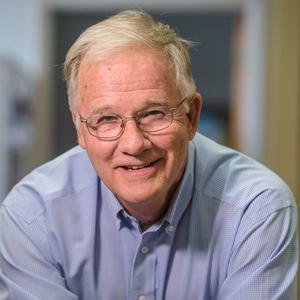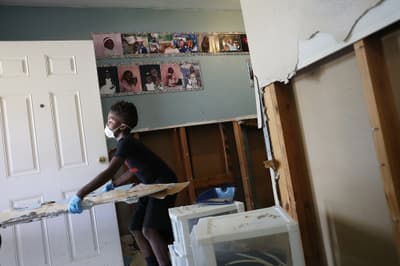For decades, Houston and its surrounding region has been one of the fastest growing metropolitan centers in the United States, with the population of Harris County rising from 1.75 million in 1970 to more than 4.5 million today. But as population soared, developers in southeast Texas were allowed to build on whatever land they could find, including wide swaths of drained wetlands, with little thought of flood risk.
Tropical Storm Harvey reclaimed much of that land, dumping more than 40 inches of rain in a matter of days and flooding as much as 30 percent of Harris County. In the wake of the storm’s catastrophic damage, flood expert Philip Bedient says business-as-usual building practices in the Houston area must change. “We cannot continue to develop just for the bottom line,” he says. “We’re going to have to develop in smart, resilient ways. Otherwise, Houston is going to be forever known as the flood capital of the United States.”
Bedient is a civil and environmental engineer at Rice University where he directs the Severe Storm Prediction, Education, and Evacuation from Disasters Center (SSPEED). He has advised the city of Houston on low-impact development practices that help to mitigate flooding. In an interview with Yale Environment 360, he talked about southeast Texas’ haphazard development boom, how communities should approach rebuilding after Harvey, and how the region needs a network of flood mitigation policies and technologies to protect it from future climate change-fueled storms.
Yale Environment 360: Harris County, which includes the city of Houston, has experienced phenomenal population growth in the last few years. You’ve described the building practices in the area as “The Wild West.” How so, and how did that contribute to the current disaster?
Philip Bedient: Most of that Wild West [building] was years ago. We have a lot of legacy areas around that were built in the ’60s, and the ’70s, and the ’80s, in the fast boom-or-bust era. It was also a time where our flood control policies were not very strong at all. A lot of those areas were built with a lot of high density, with not a whole lot of green space, with not a whole lot of good practice. Very little attention went into it. That’s all changed, but it didn’t change until the ’90s, and it was a day late and a dollar short, because so much of the area had already been developed.
e360: Are there zoning regulations now that, say, prohibit building in a 100-year flood plain?
Bedient: No, they [local officials] still allow building in the flood plain, but I have a feeling that a lot of this is getting ready to go through a change. I do know that they’re starting to think seriously about putting some additional [water] storage out on the west side, in the Katy Prairie area, and try to do a better job with the reservoirs that are out there now. But don’t forget, we just had the largest flood in U.S. history spread out over an entire county. There’s no way we could’ve come out of this without some flooding. But it would’ve been a lesser amount, if we had had some of these policies in place.
“When you get three feet of rainfall spread uniformly over a 1,700-square-mile area, it’s pretty daunting.”
e360: Were there any surprises for you regarding the pattern of flooding in the Houston area?
Bedient: No real surprises, other than it’s the largest amount of rainfall to ever befall an urban area in the history of the United States. When you get 3 feet of rainfall, pretty much spread uniformly over a 1,700-square-mile area, it’s pretty daunting.
e360: You’ve worked with the city of Houston to evaluate different types of low-impact development. What does this look like?
Bedient: You can do everything from an individual green roof, or a small green area associated with a building, all the way to what I call green infrastructure, which would be using a greenway or green belt, and adding [water] retention wherever you can, and minimizing impervious surfaces. We’ve recommended that at all different levels.
When I came to Houston originally, I worked on the Woodlands, up on the Northside, which is one of the best-designed flood-protected communities anywhere. We did that in the ’70s. There are other areas around Harris County, out in Fort Bend County and in the Sugar Land area, where these are practiced, and they actually worked well during this flood. But unfortunately, we need to do a lot more of that in Houston. I do think that they are going to begin to turn in that direction. This is the third year in a row of major flooding. They’re really going to have no choice but to turn in that direction.
Kristopher Garner helps clean up the damage to his grandmother's property in Houston, Texas following Tropical Storm Harvey. Joe Raedle/Getty Images
e360: You’ve also worked on flood resiliency with the Texas Medical Center, which fared pretty well during Harvey. Tell me about how you advised that facility.
Bedient: We helped rebuild the Med Center and redesigned the whole infrastructure post-Allison. We have a flood warning system that they rely upon. All of that worked really, really well during this storm. This was the highest recorded levels ever on the bayou next to the Medical Center, by probably more than a couple of feet. The Med Center actually saw a little bit of flooding, but it was absolutely minor compared to everything else we’re seeing in the city of Houston. The system worked perfectly.
e360: They’ve got submarine doors, I understand, in their underground tunnels.
Bedient: They brought in shipbuilders from the Northeast the day after Allison, and they started designing these gates and doors to be completely waterproof. They work very well.
“We’re going to probably end up looking at a massive buyout… There’s got to be an infusion of money to get those people out of harm’s way.”
e360: There is an ongoing federal and county project known as Project Brays, which is trying to reduce the risk of flooding along the Brays Bayou with channel widening and storm water retention basins. Is this an effective approach? If so, is more of the same needed?
Bedient: I would say that Project Brays is the only hope those people had, but we just saw about a 500-year flood, and that is far beyond anything that Project Brays was ever designed to do. It will still help the next time we get the 100-year [flood]. But those people in Meyerland have been flooded now three years in a row. I think we’re going to probably end up looking at a massive buyout. There’s going to have to be some sort of a major shift in policy. There’s got to be an infusion of money to really make this happen and get those people out of harm’s way.
e360: Major shifts and infusions of money are not the easiest things to come by.
Bedient: No, they’re not, especially with some of the senators we have. We’ll leave it at that.
e360: If this is Houston’s Katrina, is there receptivity now to major shifts in the way this region thinks about development?
Bedient: I think if there weren’t a major shift now, I would be very surprised. Unfortunately, there are a bunch of developers who just try to meet the bare bones minimum, and we’re going to have to turn that thinking around. We cannot continue to develop just for the bottom line. We’re going to have to develop in smart, resilient ways. Otherwise, Houston is going to be forever known as the flood capital of the United States.
e360: Your center, as well as Texas A&M at Galveston, have put forth various proposals to protect the region from storm surge. The Texas state legislature and local officials are now supporting the so-called coastal spine, or “Ike Dike,” a series of floodgates along the coast that can be closed when needed. In April, Texas land commissioner, George P. Bush, asked President Trump for $15 billion to build the project. If that money doesn’t come through, then what?
Bedient: I hope it does. I hope that we begin to do something. It’s been nine years since [Hurricane] Ike. We’ll see. But I’m also [not] going to be surprised to see… a competition for money for inland flood defense, which is what just happened here. This wasn’t a surge event. We had no surge at all. It was all inland flooding. Monies are going to begin to flow, but the question is, what are they going to be used for? And what is their best purpose? I’m not in any position to try to make those political decisions, but hopefully, the right decisions get made about how to spread the money around appropriately to protect all of the critical facilities, all these neighborhoods, as well as the coastline.
e360: What does the SSPEED Center’s modeling tell us about a worst-case scenario hurricane hitting the area?
Bedient: The SSPEED Center scenario says that even if a coastal spine [were built], you would really still need even some in-bay elements. We’ve advocated for the mid-bay solution, particularly to protect the Houston Ship Channel.
“We’ve got to take flood protection a lot more seriously than we have in the past.”
e360: That’s the solution that your center has put forward. What does it entail?
Bedient: Our mid-bay is basically a dike that runs down alongside the Houston Ship Channel, all the way out toward Galveston Bay. But about midway down, it cuts over and connects with the existing Texas City dike. It protects a big bay area, including all of the Clear Lake area, and in particular, provides an extra level of protection for the Houston Ship Channel. It involves a coastal spine. We think that actually all of it, all the elements together, really need to be built, both a coastal spine, as well as mid-bay elements, because just the coastal spine will not be fully protective.
This storm hit Corpus. It hit Rockport. But it very easily could’ve come in and hit Houston. If it had come into Houston with a direct hit, we would’ve seen massive damage within the Houston Ship Channel area, spills, environmental impacts, because there’s nothing out there to protect it right now. They’re sitting ducks. You can’t trust just a single line of defense.
e360: Given the reality of climate change, the Houston region will face even more powerful hurricanes, more heavy rain events, higher storm surges. Will a place like Houston even be habitable in a century?
Bedient: That’s a really good question, but then we’ve learned to live with big storms over the years. If indeed they’re going to start to get bigger and more intense, which I think they are – I think we’re seeing it now, and I think we’ve seen it in the last three years. If that’s going to happen, then we’ve got to take flood protection a lot more seriously than we have in the past. It needs to become No. 1 priority.
Houston helped put a man on the moon. Houston is the leader in the medical field. It could also begin to be a smart, resilient city if it puts its mind to it. That’s all it’s got to do.




